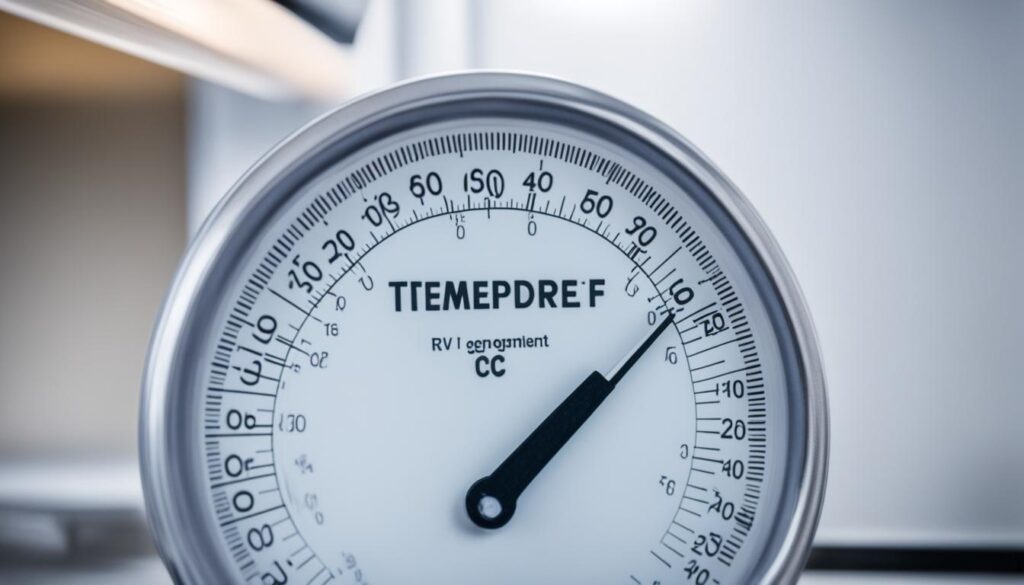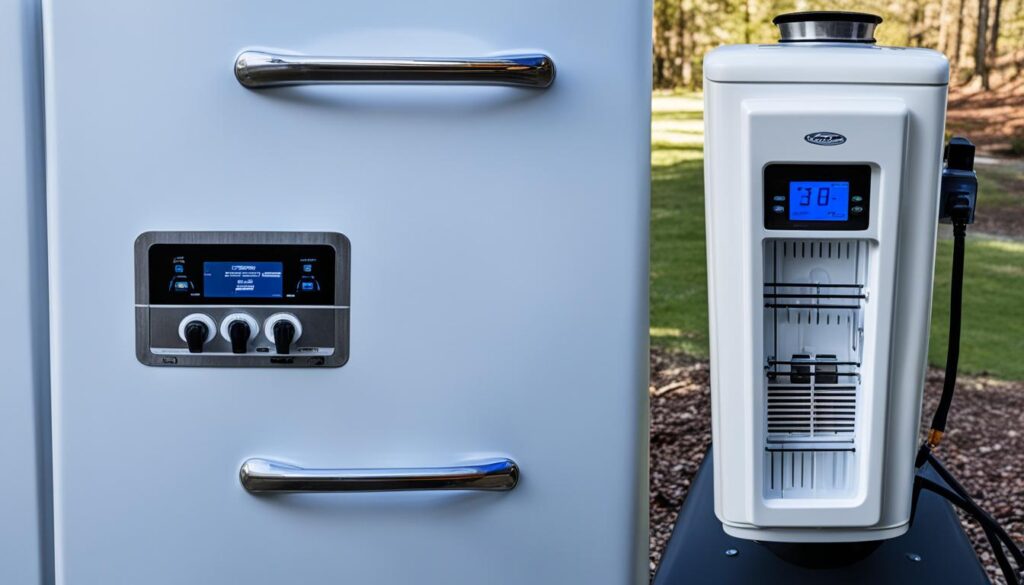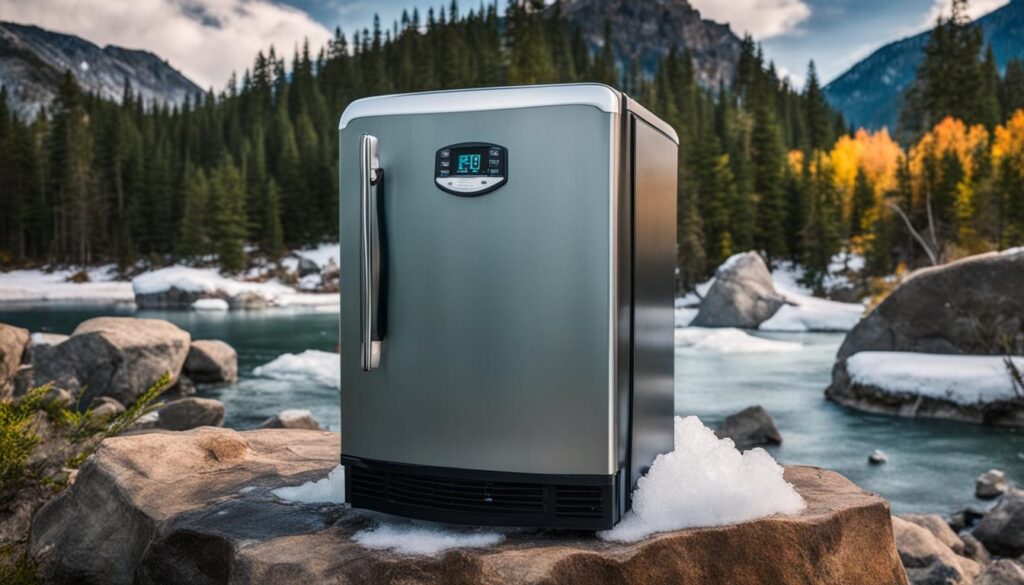Have you ever wondered how long it takes for an RV fridge to get cold? Is it a matter of minutes, hours, or even days? In this comprehensive guide, I will unravel the mystery behind RV fridge cooling time and provide you with all the information you need to know.
Many factors can affect the cooling time of an RV fridge. The size of the fridge and whether it is a regular RV fridge or a small pop-up one play a significant role. But did you know that the type of fridge you have also influences the cooling process? Absorption fridges, commonly found in RVs, take longer to cool because they remove heat using chemicals instead of injecting cold air.
So, how long does it actually take for an RV fridge to get cold? Is there a way to speed up the cooling process? And how can you keep your RV refrigerator cold once it has reached the optimal temperature? Get ready to uncover the answers to these burning questions and more in this comprehensive guide.
Key Takeaways:
- RV fridges can take anywhere from 4-8 hours to get cold, depending on their size and type.
- Absorption fridges, commonly found in RVs, take longer to cool because they remove heat using chemicals.
- Emptying the fridge, using bags of ice or pre-cooled items, and using a fridge fan can help speed up the cooling process.
- Leveling your RV, promoting good airflow, and keeping the fridge door closed can help maintain a cold temperature.
- Monitoring the temperature and maintaining the fridge’s door seal are essential for optimal cooling.
Contents
Tips for Faster Cooling of RV Fridge
When it comes to cooling your RV fridge quickly, there are several tips you can follow to minimize the waiting time. By implementing these strategies, you can ensure that your fridge reaches the desired temperature in a shorter period, allowing you to enjoy cold drinks and fresh food in no time.
Empty the Fridge for Better Airflow
Before cooling your RV fridge, make sure to remove all food and beverages. This step is essential as it allows for better airflow, enabling the cooling system to work more efficiently. An empty fridge will cool down faster compared to one that is filled with items at room temperature.
Utilize Ice Packs and Frozen Bottles
Another effective way to speed up the cooling process is by using ice packs or frozen water bottles. Place them inside the fridge to help lower the temperature quickly and create a colder environment. These alternatives to traditional bags of ice are convenient and can be reused, making them ideal for RV trips.
Install a Fridge Fan
A fridge fan can significantly improve air circulation inside your RV fridge, leading to faster cooling times. These small and inexpensive devices can be easily installed and help distribute cold air more evenly throughout the refrigerator. By eliminating hot spots and maintaining consistent temperatures, a fridge fan can reduce the overall cooling time.
Promote Good Airflow and Level Your RV
It is crucial to ensure proper airflow and leveling of your RV to achieve faster cooling. Avoid overpacking the fridge, as this can restrict airflow and hinder the cooling process. Keep the vents clear and allow the cold air to circulate freely inside the refrigerator. Additionally, leveling your RV will help the fridge operate more efficiently and optimize cooling performance.
Implementing these tips will help you reduce the typical cooling time for an RV refrigerator. By emptying the fridge, utilizing ice packs or frozen bottles, installing a fridge fan, and promoting good airflow, you can expedite the cooling process and have your RV fridge chilled and ready to use in no time.
How to Keep Your RV Refrigerator Cold
Once your RV refrigerator has cooled down, it is important to take steps to ensure it stays cold for the duration of your trip. Here are some tips to help you maintain a cold temperature in your RV fridge:
Level Your RV
Properly leveling your RV is crucial for the fridge to operate efficiently. This is because leveling allows gravity to work correctly, ensuring the cooling system functions optimally. Be sure to check that your RV is level before putting any items in the fridge.
Promote Good Airflow
To maintain a cold temperature, it is important to promote good airflow inside the fridge. Avoid overpacking the fridge, as this can restrict the flow of cold air. Additionally, make sure the fridge vents are clear from any obstructions to ensure proper ventilation.
Turn on the Fridge in Advance
To reach the optimal temperature, it is recommended to turn on your RV fridge at least 24 hours before you plan to leave. This will give the fridge enough time to cool down and get ready to store your food and beverages.
Ensure Power Supply
Keeping your RV connected to 12V shore power or ensuring that your house batteries are fully charged is crucial for maintaining a cold temperature in the fridge. This will help power the fridge effectively and ensure it continues to cool your items throughout your trip.
Keep the Refrigerator Door Closed
Avoid frequently opening the refrigerator door, as this can cause the cool air to escape and increase the temperature inside the fridge. Make a habit of opening the door only when necessary and closing it promptly to keep the cold air trapped inside.
Park in the Shade
If possible, find a shaded spot to park your RV. Direct sunlight can heat up the exterior of the RV, which in turn can affect the temperature inside the fridge. By parking in the shade, you can help minimize the heat transfer and maintain a colder temperature inside the fridge.
Stock with Cold Products
To keep your RV refrigerator cold, stock it with pre-cooled items such as leftovers from your home fridge or purchased ice. By starting with cold items, you can help maintain the cold temperature inside the fridge and reduce the strain on the cooling system.
Tips to Keep Your RV Refrigerator Cold
| Tip | Description |
|---|---|
| Level Your RV | Properly leveling your RV allows the fridge to operate efficiently. |
| Promote Good Airflow | Avoid overpacking and keep fridge vents clear to maintain proper ventilation. |
| Turn on the Fridge in Advance | Start the fridge at least 24 hours before your trip to reach optimal temperature. |
| Ensure Power Supply | Keep your RV connected to power or ensure fully charged batteries. |
| Keep the Refrigerator Door Closed | Avoid frequent door openings to prevent cool air from escaping. |
| Park in the Shade | Find a shaded spot to minimize heat transfer to the fridge. |
| Stock with Cold Products | Pre-cool items and stock with cold products to maintain the cold temperature. |
Monitoring and Maintaining RV Fridge Temperature
As an RV owner, it is essential to keep a close eye on the temperature of your fridge to ensure it is operating correctly and maintaining the ideal cooling conditions. Monitoring the temperature not only helps prevent food spoilage but also allows you to identify any possible issues that may arise. There are a few key steps you can take to effectively monitor and maintain the temperature of your RV fridge.
Use an Inexpensive Temperature Gauge
One of the easiest ways to monitor the temperature inside your RV fridge is by using an inexpensive temperature gauge. This device allows you to accurately measure the temperature and make adjustments if necessary. By keeping a close watch on the temperature, you can ensure that your fridge is consistently cold and maintaining food safety standards.
Regular Defrosting
To maintain proper cooling, it is crucial to defrost your RV fridge regularly. Ice build-up can hinder the performance of the fridge and inhibit its cooling capabilities. Make it a routine to defrost the fridge when you notice any frost accumulation. This will help the fridge work efficiently and keep your food fresh and cool.
Inspect the Door Seal
The door seal of your RV fridge plays a vital role in maintaining the temperature. Over time, the seal may wear out or become damaged, allowing cool air to escape and warm air to enter. To prevent this, regularly inspect the door seal for any signs of wear or damage. If you notice any problems, such as gaps or tears, it is crucial to replace the door seal promptly. A tight and secure door seal ensures proper cooling and preserves energy efficiency.
| Benefits of Monitoring and Maintaining RV Fridge Temperature | Prevent food spoilage | Preserve energy efficiency | Ensure food safety |
|---|---|---|---|
| Actions required | Use an inexpensive temperature gauge | Regularly defrost the fridge | Inspect and replace the door seal if necessary |
| Frequency | Ongoing | As needed | Regular inspections and replacement when needed |
By regularly monitoring the temperature, defrosting when needed, and ensuring a tight door seal, you can maintain optimal cooling in your RV fridge. These simple maintenance practices will not only keep your food fresh and safe but also help sustain energy efficiency, allowing you to enjoy your time on the road without any concerns about your refrigerator’s performance.

Gas vs Electric Operation for RV Fridges
When it comes to operating an RV fridge, one of the key decisions you’ll face is whether to use gas or electric power. Each option has its own advantages and considerations that you need to take into account.
Gas operation, typically utilizing propane, can cool the fridge faster compared to electric operation. This can be especially beneficial when you need to chill your RV fridge quickly. However, it’s important to note that gas operation may result in more fluctuations in temperature due to external temperature changes. Additionally, proper leveling of your RV is crucial to ensure efficient cooling with gas power.
On the other hand, electric operation is generally regarded as safer. It eliminates the need to handle propane, reducing potential safety risks. However, electric operation may take longer to cool the fridge compared to gas. If you choose to use electric power, it’s recommended to wait patiently for the fridge to reach the desired temperature.
Most RV fridges feature an auto setting that provides a convenient solution. This setting automatically switches between gas and electric power depending on the circumstances. For example, when your RV is stationary and plugged into a 110-volt power source, the fridge will utilize electric power. Conversely, when you’re on the move, the fridge will switch to gas power using propane. This auto setting ensures optimal cooling efficiency while providing the necessary flexibility for different situations.
In summary, gas operation can cool your RV fridge faster but may fluctuate more with outside temperature and require proper leveling. Electric operation, while generally regarded as safer, may take longer to cool. Utilizing the auto setting of your RV fridge allows for the best of both worlds, optimizing cooling based on the power source available.

Comparison of Gas and Electric Operation for RV Fridges
| Gas Operation | Electric Operation |
|---|---|
| Can cool the fridge faster | May take longer to cool |
| More fluctuations in temperature due to external temperature changes | Generally regarded as safer |
| Requires proper leveling for efficient cooling | No handling of propane required |
| Optimal for quick chilling | Safer option |
FAQ: Frequently Asked Questions about RV Fridge Cooling
In this section, I will answer some common questions about RV fridge cooling to help you understand the factors that affect cooling time and how to optimize the cooling process.
What factors affect the cooling time of an RV fridge?
The size of the fridge and whether it is a regular RV fridge or a small popup one can affect the cooling time. Generally, larger fridges take longer to cool down.
How can I speed up the cooling process of my RV fridge?
To speed up the cooling process, empty the fridge before cooling it to allow for better airflow. Using bags of ice or pre-cooled items can also help cool the fridge faster. Additionally, installing a fridge fan inside the RV fridge can improve air circulation and reduce cooling times.
How long does it typically take for an RV fridge to reach the optimal temperature?
It usually takes about 24 hours for an RV fridge to cool down and reach the optimal temperature. Plan ahead and start the cooling process at least a day before you need to use the fridge.
Can I use ice packs or frozen water bottles to cool my RV fridge?
Yes, using ice packs, frozen water bottles, or other variations of ice can help cool the fridge faster. Place them inside the fridge to help lower the temperature.
Do I need to level my RV for optimal cooling of the fridge?
Yes, it is important to level your RV for proper functioning of the fridge and efficient cooling. This allows the fridge’s cooling system to operate correctly and maintain a consistent temperature.
What should I do to maintain the temperature of my RV fridge?
To maintain the temperature of your RV fridge, keep the fridge door closed as much as possible to prevent cool air from escaping. Park your RV in the shade to minimize exposure to direct sunlight, and stock the fridge with cold products, such as pre-cooled leftovers or purchased ice, to help the fridge maintain a cold temperature.
How can I monitor the temperature of my RV fridge?
You can monitor the temperature of your RV fridge by using an inexpensive temperature gauge. This will help you ensure that the fridge is operating correctly and maintaining the desired temperature.
What are the benefits and downsides of gas vs electric operation for an RV fridge?
Gas operation cools the fridge faster but may fluctuate more with outside temperature and requires proper leveling. Electric operation is generally safer but may take longer to cool. It is recommended to keep the fridge on the auto setting, which will automatically switch between gas and electric power depending on the availability, to ensure optimal cooling.
FAQ
What factors affect the cooling time of an RV fridge?
The size of the fridge and whether it is a regular RV fridge or a small popup one can affect the cooling time.
How can I speed up the cooling process of my RV fridge?
Emptying the fridge, using bags of ice or pre-cooled items, and using a fridge fan can help speed up the cooling process.
How long does it typically take for an RV fridge to reach the optimal temperature?
It usually takes 24 hours for an RV fridge to cool down and reach the optimal temperature.
Can I use ice packs or frozen water bottles to cool my RV fridge?
Yes, using ice packs, frozen water bottles, or other variations of ice can help cool the fridge faster.
Do I need to level my RV for optimal cooling of the fridge?
Yes, leveling your RV is important for proper functioning of the fridge and efficient cooling.
What should I do to maintain the temperature of my RV fridge?
Keeping the fridge door closed as much as possible, parking in the shade, and stocking the fridge with cold products can help maintain the temperature.
How can I monitor the temperature of my RV fridge?
Using an inexpensive temperature gauge can help monitor the temperature inside the fridge and ensure it is operating correctly.
What are the benefits and downsides of gas vs electric operation for an RV fridge?
Gas operation cools the fridge faster but can fluctuate more with outside temperature and requires proper leveling, while electric operation is generally safer but may take longer to cool. It is recommended to keep the fridge on the auto setting to ensure optimal cooling.






